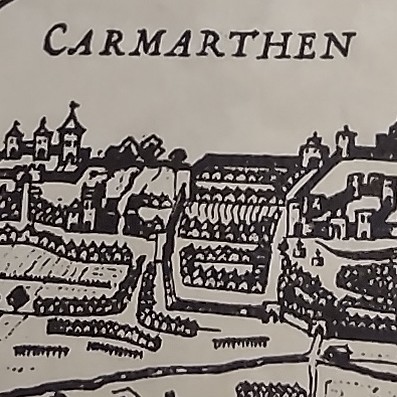St. Margaret Marloes
St Oudoceus’ Church at Llandawke, (near Laugharne, Carmarthenshire) was founded by Lady Margaret Marloes, and is one of the oldest surviving churches in West Wales. A foundation stone within the church was inscribed during the 6th Century, although the current building originates from the 13th or 14th Century and was thought to have been rebuilt as a chapel specifically for Lady Margaret, by her uncle.
Lady Margaret Marloes is believed to have been the daughter of Sir Robert Marloes and his wife (the sister of Sir Guy de Brienne, Lord Marcher of Laugharne) and although she was not a nun, she is known to have dedicated herself to a religious life. Her effigy, carved from local stone, appears inside the church at Llandawke, but is rumoured to have originally been outside in the churchyard. Interestingly, the sculpture appears in three pieces which has sparked speculation that it may have been vandalised by robbers, destroyed by Cromwells’s troops or even deliberately created in three parts to symbolise her suspected murder at the hands of the aforementioned robbers.
Lady Margaret’s religious dedication and rumoured violent death is one theory for her canonisation. More specifically, she appears to have formed a beguinage at Llandawke which may have led to her ‘canonisation by acclamation’: a testament to her good work and standing within the locality. A beguinage was a largely autonomous community of women who lived and worshipped together without withdrawing from wider society. Their central chapel was often surrounded by houses and other facilities (such as a bakery, brewery and hospital) and women from all areas of society were welcomed. In the 14th Century, St Oudoceus’ rector, Philip Marloes, would have acted as chaplain to the community and is thought to have been Lady Margaret’s brother.
St Margaret Marloes is depicted in her effigy wearing a flowing robe and with her hands either in prayer, or clasped in the pose of a heart burial, which gives special reverence to the courage and humility symbolised her heart, buried separately from her body at an unknown location.
Sefydlwyd Eglwys Sant Oudoceus yn Llan-dawg, (ger Lacharn, Sir Gaerfyrddin) gan y Fonesig Margaret Marloes, ac mae’n un o’r eglwysi hynaf sydd wedi goroesi yng Ngorllewin Cymru. Mae carreg sylfaen o fewn yr eglwys yn dwyn arysgrif o’r 6ed Ganrif, er bod yr adeilad presennol yn dyddio o’r 13eg neu’r 14eg Ganrif a chredwyd i’r eglwys gael ei hailadeiladu fel capel yn benodol i’r Fonesig Margaret, gan ei hewythr.
Credir bod y Fonesig Margaret Marloes yn ferch i Syr Robert Marloes a’i wraig (chwaer Syr Guy de Brienne, Arglwydd Fers Lacharn) ac er nad oedd hi’n lleian, gwyddys iddi gysegru ei hun i fywyd crefyddol. Mae ei delw, wedi’i cherfio o garreg leol, i’w gweld y tu mewn i’r eglwys yn Llan-dawg, ond dywedir mai y tu allan oedd y ddelw yn wreiddiol ym mynwent yr eglwys. Yn ddiddorol iawn, mae’r cerflun yn ymddangos mewn tri darn sydd wedi ennyn dyfalu y gallai fod wedi cael ei fandaleiddio gan ladron, ei ddinistrio gan fyddinoedd Cromwell neu hyd yn oed ei greu yn fwriadol mewn tair rhan fel symbol o’i llofruddiaeth honedig gan ladron.
Mae ymgysegriad crefyddol a marwolaeth dreisgar y Fonesig Margaret yn un theori pam y cafodd ei chanoneiddio. Yn fwy penodol, ymddengys iddi ffurfio beginfa yn Llan-dawg a allai fod wedi arwain at ei ‘chanoneiddio drwy fanllef’: tyst i’w gwaith da a’r parch oedd iddi yn yr ardal. Beginfa oedd cymuned o ferched ymreolaethol i raddau helaeth oedd yn byw ac yn addoli gyda’i gilydd heb ymneilltuo o’r gymdeithas ehangach. Yn aml roedd eu capel canolog wedi’i amgylchynu gan dai a chyfleusterau eraill (megis becws, bragdy ac ysbyty) ac roedd croeso i fenywod o bob rhan o’r gymdeithas. Yn y 14eg Ganrif, byddai rheithor St Oudoceus, Philip Marloes, wedi bod yn gaplan i’r gymuned a chredir ei fod yn frawd i’r Fonesig Margaret.
Mae Santes Margaret Marloes yn cael ei darlunio yn ei delw yn gwisgo gwisg laes a’i dwylo naill ai mewn gweddi, neu wedi’u plethu fel yn achos claddedigaeth y galon, sy’n talu teyrnged arbennig i’r dewrder a’r gostyngeiddrwydd sy’n nodweddu ei chalon, wedi’i chladdu ar wahân i’w chorff mewn lleoliad anhysbys.
With thanks to Friends of Friendless Churches





